Abstract
In this study, we describe the ability of hybrid mouse monoclonal antibody (mAb) to induce monocyte-mediated cytotoxicity towards human IgA1-coated E (HuIgA1-E), and the effect of mAb binding valency on Fc gamma RI-mediated ADCC. All hybrid monospecific (ms) anti-HuIgA1 and bispecific (bs) anti-HuIgA1/HRP mAb were capable of inducing monocyte-mediated lysis of HuIgA1-E, in spite of differences in mAb densities essential for optimal lysis. The cytotoxicity induced by hybrid mAb which consist of one or more mIgG2a H chains was predominantly mediated via Fc gamma RI, as shown by inhibition studies on monocytes with Fc gamma RI-blocking mAb TB-3 (approximately 80% inhibition). However, partial inhibition of mIgG1-2a and mIgG2a-2b-induced cytotoxicity (20-50%) was observed by using Fc gamma RII-blocking mAb IV.3 or CIKM5. For hybrid mIgG1-1 mAb the opposite was true; the cytotoxicity was predominantly mediated via Fc gamma RII (70-80%) and less via Fc gamma RI (20-30%). Comparing the hybrid ms anti-HuIgA1 mAb-induced cytotoxicity with the cytotoxicity induced by hybrid bs anti-HuIgA1/HRP mAb of the same isotype, we observed a decrease in cytotoxicity towards HuIgA1-E sensitized with univalently bound bs anti-HuIgA1/HRP mAb. This decrease was only found for Fc gamma RI-mediated ADCC (mIgG2a-2a, mIgG1-2a and mIgG2a-2b). This diminished recognition of univalently bound IgG relative to bivalently bound IgG by Fc gamma RI was also observed with U937 effector cells. In conclusion, this work shows that hybrid mAb are able to induce monocyte-mediated cytotoxicity towards E-HuIgA1 and that there appears to be an effect of Ag-IgG binding valency on Fc gamma RI-mediated cytotoxicity.
Full text
PDF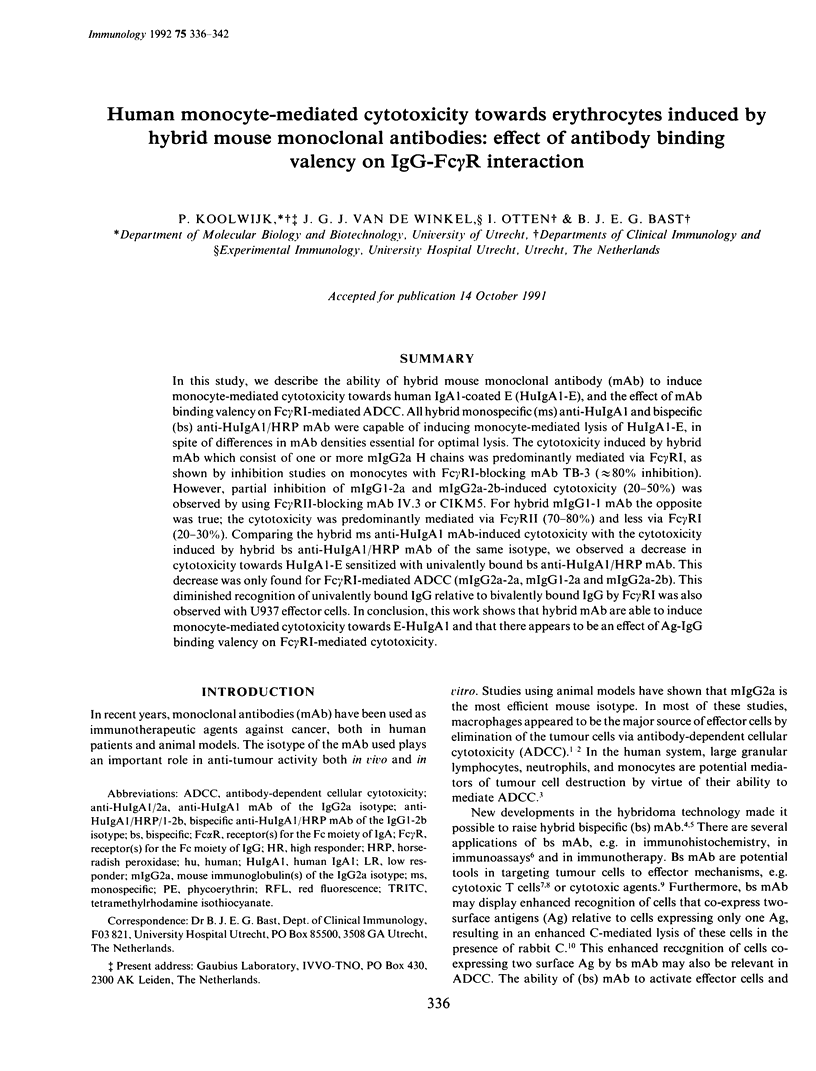
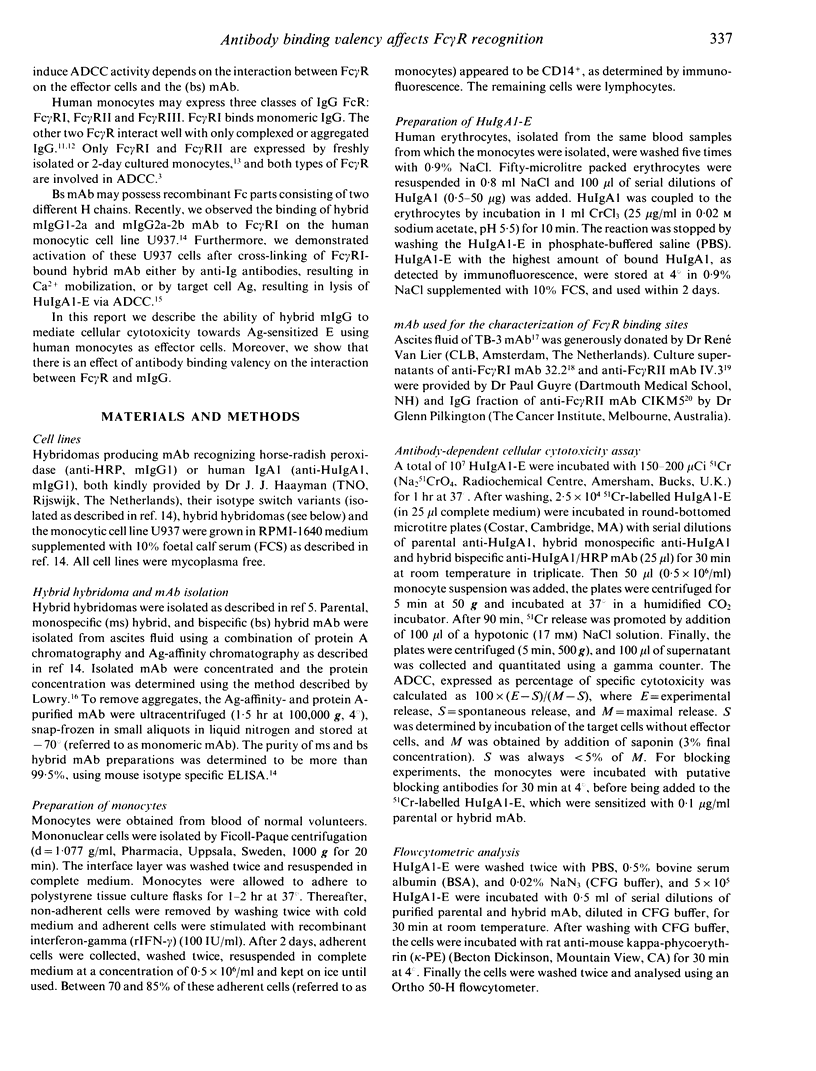
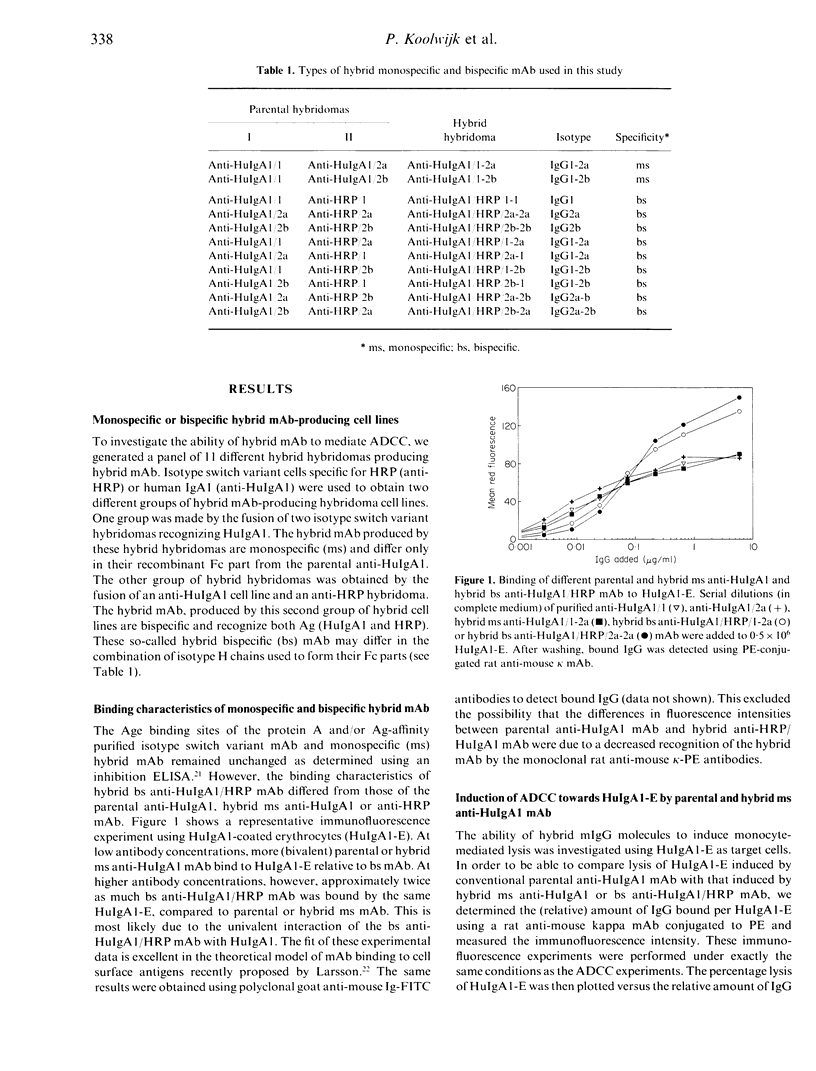
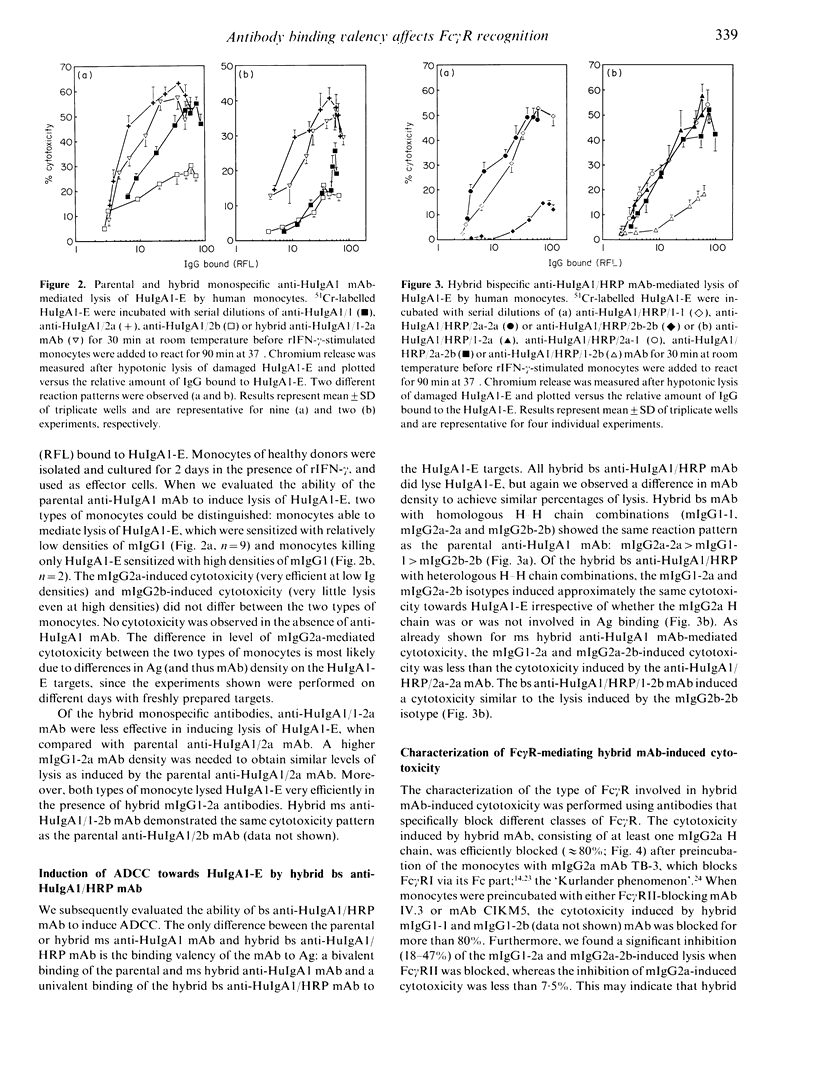
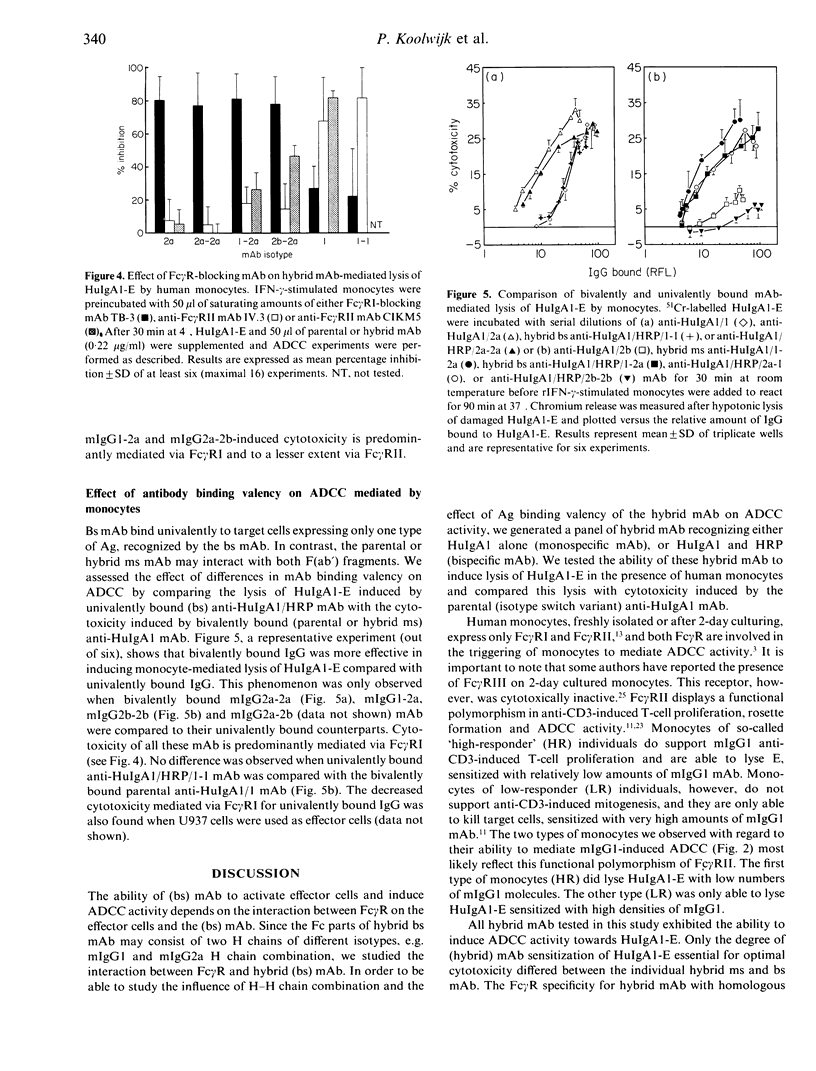
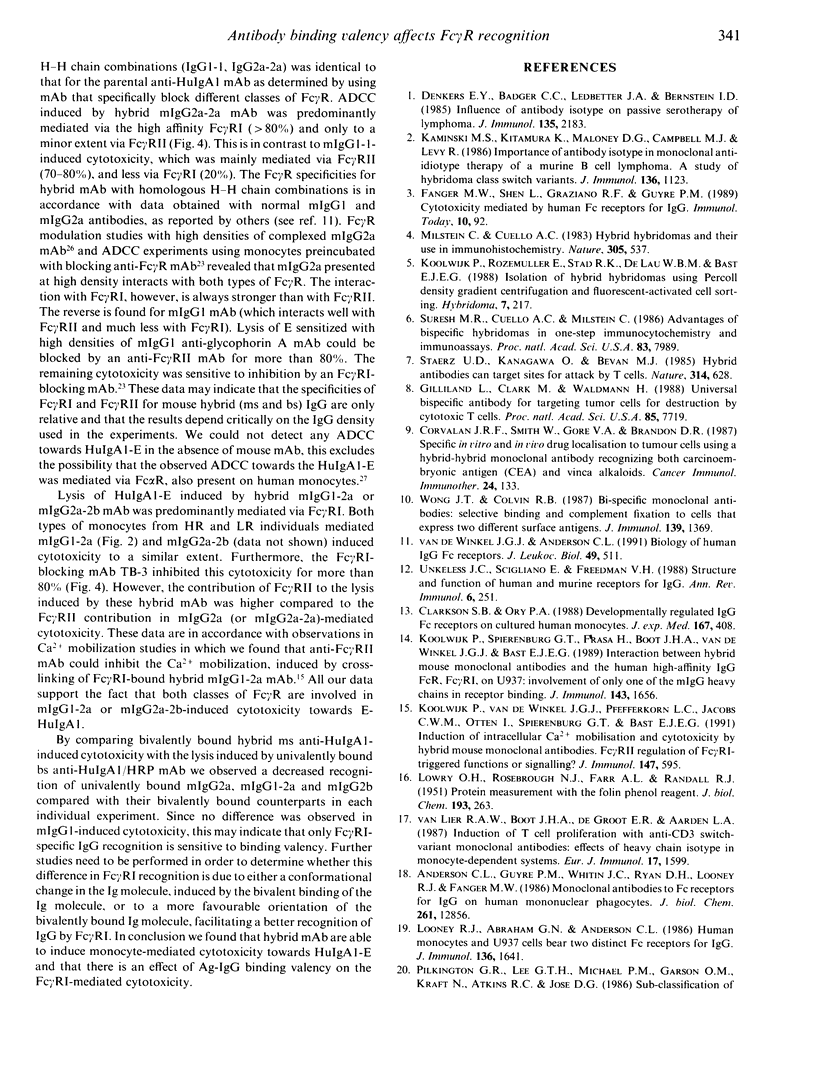
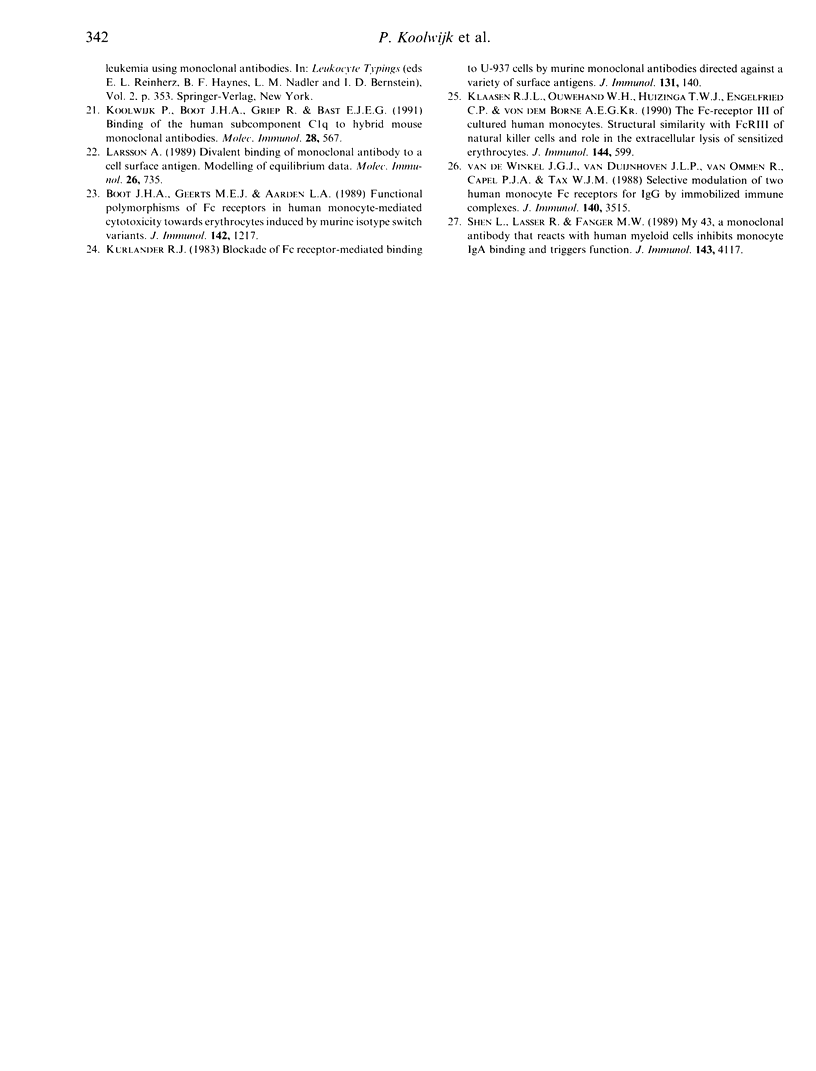
Selected References
These references are in PubMed. This may not be the complete list of references from this article.
- Anderson C. L., Guyre P. M., Whitin J. C., Ryan D. H., Looney R. J., Fanger M. W. Monoclonal antibodies to Fc receptors for IgG on human mononuclear phagocytes. Antibody characterization and induction of superoxide production in a monocyte cell line. J Biol Chem. 1986 Sep 25;261(27):12856–12864. [PubMed] [Google Scholar]
- Boot J. H., Geerts M. E., Aarden L. A. Functional polymorphisms of Fc receptors in human monocyte-mediated cytotoxicity towards erythrocytes induced by murine isotype switch variants. J Immunol. 1989 Feb 15;142(4):1217–1223. [PubMed] [Google Scholar]
- Clarkson S. B., Ory P. A. CD16. Developmentally regulated IgG Fc receptors on cultured human monocytes. J Exp Med. 1988 Feb 1;167(2):408–420. doi: 10.1084/jem.167.2.408. [DOI] [PMC free article] [PubMed] [Google Scholar]
- Corvalan J. R., Smith W., Gore V. A., Brandon D. R. Specific in vitro and in vivo drug localisation to tumour cells using a hybrid-hybrid monoclonal antibody recognising both carcinoembryonic antigen (CEA) and vinca alkaloids. Cancer Immunol Immunother. 1987;24(2):133–137. doi: 10.1007/BF00205590. [DOI] [PMC free article] [PubMed] [Google Scholar]
- Denkers E. Y., Badger C. C., Ledbetter J. A., Bernstein I. D. Influence of antibody isotype on passive serotherapy of lymphoma. J Immunol. 1985 Sep;135(3):2183–2186. [PubMed] [Google Scholar]
- Fanger M. W., Shen L., Graziano R. F., Guyre P. M. Cytotoxicity mediated by human Fc receptors for IgG. Immunol Today. 1989 Mar;10(3):92–99. doi: 10.1016/0167-5699(89)90234-X. [DOI] [PubMed] [Google Scholar]
- Gilliland L. K., Clark M. R., Waldmann H. Universal bispecific antibody for targeting tumor cells for destruction by cytotoxic T cells. Proc Natl Acad Sci U S A. 1988 Oct;85(20):7719–7723. doi: 10.1073/pnas.85.20.7719. [DOI] [PMC free article] [PubMed] [Google Scholar]
- Kaminski M. S., Kitamura K., Maloney D. G., Campbell M. J., Levy R. Importance of antibody isotype in monoclonal anti-idiotype therapy of a murine B cell lymphoma. A study of hybridoma class switch variants. J Immunol. 1986 Feb 1;136(3):1123–1130. [PubMed] [Google Scholar]
- Klaassen R. J., Ouwehand W. H., Huizinga T. W., Engelfriet C. P., von dem Borne A. E. The Fc-receptor III of cultured human monocytes. Structural similarity with FcRIII of natural killer cells and role in the extracellular lysis of sensitized erythrocytes. J Immunol. 1990 Jan 15;144(2):599–606. [PubMed] [Google Scholar]
- Koolwijk P., Boot J. H., Griep R., Bast B. J. Binding of the human complement subcomponent C1q to hybrid mouse monoclonal antibodies. Mol Immunol. 1991 Jun;28(6):567–576. doi: 10.1016/0161-5890(91)90125-4. [DOI] [PubMed] [Google Scholar]
- Koolwijk P., Rozemuller E., Stad R. K., De Lau W. B., Bast B. J. Enrichment and selection of hybrid hybridomas by Percoll density gradient centrifugation and fluorescent-activated cell sorting. Hybridoma. 1988 Apr;7(2):217–225. doi: 10.1089/hyb.1988.7.217. [DOI] [PubMed] [Google Scholar]
- Koolwijk P., Spierenburg G. T., Frasa H., Boot J. H., van de Winkel J. G., Bast B. J. Interaction between hybrid mouse monoclonal antibodies and the human high-affinity IgG FcR, huFc gamma RI, on U937. Involvement of only one of the mIgG heavy chains in receptor binding. J Immunol. 1989 Sep 1;143(5):1656–1662. [PubMed] [Google Scholar]
- Koolwijk P., Van de Winkel J. G., Pfefferkorn L. C., Jacobs C. W., Otten I., Spierenburg G. T., Bast B. J. Induction of intracellular Ca2+ mobilization and cytotoxicity by hybrid mouse monoclonal antibodies. Fc gamma RII regulation of Fc gamma RI-triggered functions or signaling? J Immunol. 1991 Jul 15;147(2):595–602. [PubMed] [Google Scholar]
- Kurlander R. J. Blockade of Fc receptor-mediated binding to U-937 cells by murine monoclonal antibodies directed against a variety of surface antigens. J Immunol. 1983 Jul;131(1):140–147. [PubMed] [Google Scholar]
- Larsson A. Divalent binding of monoclonal antibody to a cell surface antigen. Modelling of equilibrium data. Mol Immunol. 1989 Aug;26(8):735–739. doi: 10.1016/0161-5890(89)90033-3. [DOI] [PubMed] [Google Scholar]
- Looney R. J., Abraham G. N., Anderson C. L. Human monocytes and U937 cells bear two distinct Fc receptors for IgG. J Immunol. 1986 Mar 1;136(5):1641–1647. [PubMed] [Google Scholar]
- Milstein C., Cuello A. C. Hybrid hybridomas and their use in immunohistochemistry. Nature. 1983 Oct 6;305(5934):537–540. doi: 10.1038/305537a0. [DOI] [PubMed] [Google Scholar]
- Shen L., Lasser R., Fanger M. W. My 43, a monoclonal antibody that reacts with human myeloid cells inhibits monocyte IgA binding and triggers function. J Immunol. 1989 Dec 15;143(12):4117–4122. [PubMed] [Google Scholar]
- Staerz U. D., Kanagawa O., Bevan M. J. Hybrid antibodies can target sites for attack by T cells. Nature. 1985 Apr 18;314(6012):628–631. doi: 10.1038/314628a0. [DOI] [PubMed] [Google Scholar]
- Suresh M. R., Cuello A. C., Milstein C. Advantages of bispecific hybridomas in one-step immunocytochemistry and immunoassays. Proc Natl Acad Sci U S A. 1986 Oct;83(20):7989–7993. doi: 10.1073/pnas.83.20.7989. [DOI] [PMC free article] [PubMed] [Google Scholar]
- Unkeless J. C., Scigliano E., Freedman V. H. Structure and function of human and murine receptors for IgG. Annu Rev Immunol. 1988;6:251–281. doi: 10.1146/annurev.iy.06.040188.001343. [DOI] [PubMed] [Google Scholar]
- Van Lier R. A., Boot J. H., De Groot E. R., Aarden L. A. Induction of T cell proliferation with anti-CD3 switch-variant monoclonal antibodies: effects of heavy chain isotype in monocyte-dependent systems. Eur J Immunol. 1987 Nov;17(11):1599–1604. doi: 10.1002/eji.1830171112. [DOI] [PubMed] [Google Scholar]
- Wong J. T., Colvin R. B. Bi-specific monoclonal antibodies: selective binding and complement fixation to cells that express two different surface antigens. J Immunol. 1987 Aug 15;139(4):1369–1374. [PubMed] [Google Scholar]


